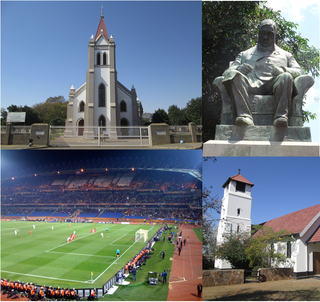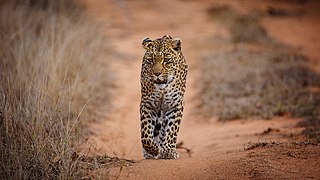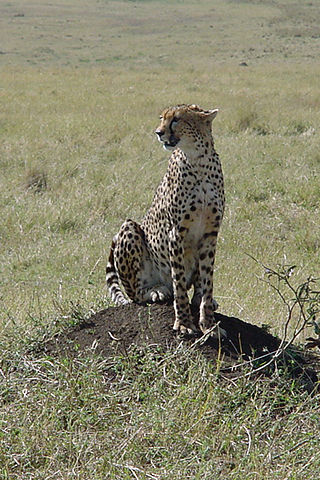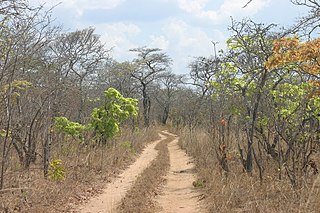
The African buffalo is a large sub-Saharan African bovine. There are five subspecies that are recognized as being valid. Syncerus caffer caffer, the Cape buffalo, is the nominotypical subspecies, and the largest one, found in Southern Africa and East Africa. S. c. nanus is the smallest subspecies, common in forest areas of Central Africa and West Africa, while S. c. brachyceros is in West Africa and S. c. aequinoctialis is in the savannas of East Africa. The adult African buffalo's horns are its characteristic feature: they have fused bases, forming a continuous bone shield across the top of the head, referred to as a "boss".

Rustenburg is a city at the foot of the Magaliesberg mountain range. Rustenburg is the most populous city in North West province, South Africa. In 2017, the city's Gross Domestic Product (GDP) reached ZAR 63.8 billion, accounting for 21.1% of the GDP of the North West Province, and 1.28% of the GDP of South Africa. Rustenburg was one of the official host cities of the 2010 FIFA World Cup, being in close proximity to Phokeng, the capital of the Royal Bafokeng Nation, where the Royal Bafokeng Stadium is located. The England national football team also used this as their base camp for the tournament.

Gorongosa National Park is at the southern end of the Great African Rift Valley in the heart of central Mozambique, Southeast Africa. The more than 4,000 square kilometres (1,500 sq mi) park comprises the valley floor and parts of surrounding plateaus. Rivers originating on nearby Mount Gorongosa water the plain.

The Madikwe Game Reserve is a protected area in South Africa. Named after the Madikwe or Marico River, on whose basin it is located. It comprises 750 km2 of bushland north of the small town of Groot-Marico up to the Botswana border. It was opened in 1994.

The East Sudanian savanna is a hot, dry, tropical savanna ecoregion of Central and East Africa.

The Pilanesberg is a mountain in the North West Province, South Africa. The mountain is an ancient volcanic structure, circular in shape, that rises from flat surrounding plains. It is formed by three concentric ridges or rings of hills, of which the outermost has a diameter of about 24 km. The Pilanesberg is located 100 km to the North-West of Pretoria and is for the greater part enclosed in a protected area known as Pilanesberg National Park.

The wildlife of Botswana refers to the flora and fauna of this country. Botswana is around 90% covered in savanna, varying from shrub savanna in the southwest in the dry areas to tree savanna consisting of trees and grass in the wetter areas. Even under the hot conditions of the Kalahari Desert, many species survive; in fact the country has more than 2500 species of plants and 650 species of trees. Vegetation and its wild fruits are also extremely important to rural populations living in the desert and are the principal source of food, fuel and medicine for many inhabitants.

The wildlife of Zimbabwe occurs foremost in remote or rugged terrain, in national parks and private wildlife ranches, in miombo woodlands and thorny acacia or kopje. The prominent wild fauna includes African buffalo, African bush elephant, black rhinoceros, southern giraffe, African leopard, lion, plains zebra, and several antelope species.

The wildlife of Chad is composed of its flora and fauna. Bush elephants, West African lions, buffalo, hippopotamuses, Kordofan giraffes, antelopes, African leopards, cheetahs, hyenas, and many species of snakes are found there, although most large carnivore populations have been drastically reduced since the early 20th century. Elephant poaching, particularly in the south of the country in areas such as Zakouma National Park, is a severe problem.

The Eastern miombo woodlands (AT0706) are an ecoregion of grassland and woodland in northern Mozambique, southern Tanzania, and southeastern Malawi.

The wildlife of Zambia refers to the natural flora and fauna of Zambia. This article provides an overview, and outline of the main wildlife areas or regions, and compact lists of animals focusing on prevalence and distribution in the country rather than on taxonomy. More specialized articles on particular groups are linked from here.

The wildlife of Somalia includes the flora and fauna of Somalia, which is extremely diverse due to the country's location between the temperate and the tropical zones. Somalia has a long coastline, bordered by the Indian Ocean in the east and Red Sea in the north. The northwestern and central parts of the country are arid, or very dry. The southern and northeastern regions are semi-arid, receiving slightly more rainfall than the central and northwest regions. The coastal region is more humid due to its proximity to the ocean. Somalia is home to over 727 species of birds and boasts over 177 species of mammals.
The North West Parks Board is a governmental organisation responsible for the management of protected areas and public nature reserves in North West Province, South Africa.

Mabalingwe Nature Reserve, is located 38 km west of Bela Bela, in the Limpopo province of South Africa, and is about 12,000 hectare in area. It is in an easily accessible, malaria-free area of the Transvaal bushveld, around an hour-and-a-half drive from Johannesburg.

Sabi Sand Game Reserve is located adjacent to the Kruger National Park in the Lowveld of Mpumalanga, South Africa. Officially named Sabi Sand Wildtuin, the Sabi Sand Game Reserve consists of a group of private game reserves. The Newington Gate is at 24°52′9″S31°24′16″E and west of the Kruger Gate and Skukuza camp of Kruger Park. Other entrances are Gowrie Gate in the far north and Shaws Gate in the south.

The East African cheetah, is a cheetah population in East Africa. It lives in grasslands and savannas of Tanzania, Kenya, Uganda and Somalia. The cheetah inhabits mainly the Serengeti ecosystem, including Maasai Mara, and the Tsavo landscape.
Mapesu Private Game Reserve is a game reserve in Limpopo Province, South Africa. The reserve adjoins the Mapungubwe National Park and World Heritage Site, with which it shares a 12.5 km Northern border. The main entrance gate to the reserve is located approximately 7 km east of Mapungubwe's entrance gate. It was established in 2014 and covers an area of over 7,200 hectares. The reserve protects various bird, mammal and tree species and is slated to become part of the Greater Mapungubwe Transfrontier Conservation Area in phase 2 as part of the proposed Limpopo Valley Game Reserve.

The Southern Acacia–Commiphora bushlands and thickets is a tropical grasslands, savannas, and shrublands ecoregion in Tanzania and Kenya. It includes portions of Serengeti National Park and Ngorongoro Conservation Area, which are designated World Heritage Sites and biosphere reserves for their outstanding wildlife and landscapes. It is one of three Acacia–Commiphora bushlands and thickets ecoregions in eastern Africa.

The Southern miombo woodlands is a tropical grasslands and woodlands ecoregion extending across portions of Malawi, Mozambique, Zambia, and Zimbabwe.


































